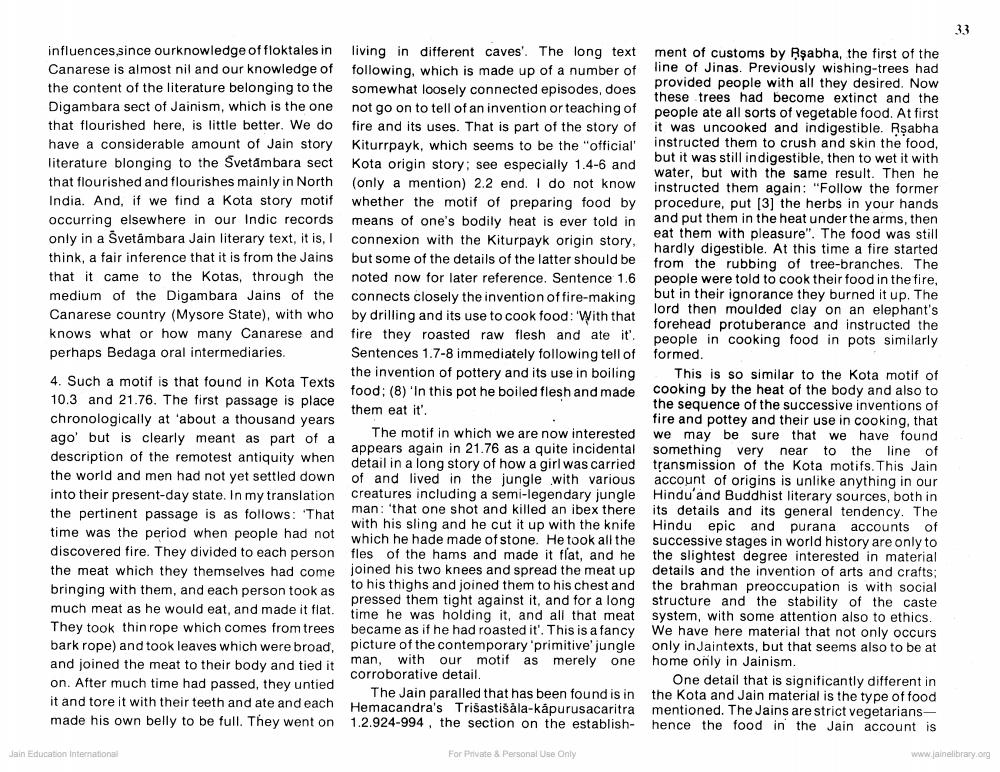________________
33
influences since ourknowledge of floktales in living in different caves'. The long textment of customs by Rşabha, the first of the Canarese is almost nil and our knowledge of following, which is made up of a number of line of Jinas. Previously wishing-trees had
provided people with all they desired. Now the content of the literature belonging to the somewhat loosely connected episodes, does
these trees had become extinct and the Digambara sect of Jainism, which is the one not go on to tell of an invention or teaching of people ate all sorts of vegetable food. At first that flourished here, is little better. We do fire and its uses. That is part of the story of it was uncooked and indigestible. Rşabha have a considerable amount of Jain story Kiturrpayk, which seems to be the official
hich seems to be the official instructed them to crush and skin the food, literature blonging to the Svetambara sect Kota origin story: see especially 1.4-6 and
but it was still indigestible, then to wet it with
water, but with the same result. Then he that flourished and flourishes mainly in North (only a mention) 2.2 end. I do not know
only a mention) 2.2 end. I do not know instructed them again: "Follow the former India. And, if we find a kota story motif whether the motif of preparing food by procedure, put [3] the herbs in your hands occurring elsewhere in our Indic records means of one's bodily heat is ever told in and put them in the heat under the arms, then only in a Svetambara Jain literary text, it is connexion with the Kiturpayk origin story,
eat them with pleasure". The food was still
hardly digestible. At this time a fire started think, a fair inference that it is from the Jains but some of the details of the latter should be from the rubbing of tree-branches. The that it came to the Kotas, through the noted now for later reference. Sentence 1.6 people were told to cook their food in the fire, medium of the Digambara Jains of the connects closely the invention of fire-making
but in their ignorance they burned it up. The
lord then moulded clay on an elephant's Canarese country (Mysore State), with who by drilling and its use to cook food: 'With that
forehead protuberance and instructed the knows what or how many Canarese and fire they roasted raw flesh and ate it'. people in cooking food in pots similarly perhaps Bedaga oral intermediaries. Sentences 1.7-8 immediately following tell of formed.
the invention of pottery and its use in boiling This is so similar to the Kota motif of 4. Such a motif is that found in Kota Texts food: (8) 'In this pot he boiled flesh and made
cooking by the heat of the body and also to 10.3 and 21.76. The first passage is place them eat it'.
the sequence of the successive inventions of chronologically at about a thousand years
fire and pottey and their use in cooking, that ago' but is clearly meant as part of a
The motif in which we are now interested we may be sure that we have found
appears again in 21.76 as a quite incidental something very near to the line of description of the remotest antiquity when
detail in a long story of how a girl was carried transmission of the Kota motifs. This Jain the world and men had not yet settled down of and lived in the jungle with various account of origins is unlike anything in our into their present-day state. In my translation creatures including a semi-legendary jungle Hindu'and Buddhist literary sources, both in the pertinent passage is as follows: 'That
followe: That man: that one shot and killed an ibex there its details and its general tendency. The
with his sling and he cut it up with the knife Hindu epic and purana accounts of time was the period when people had not which he hade made of stone. He took all the successive stages in world history are only to discovered fire. They divided to each person fles of the hams and made it flat, and he the slightest degree interested in material the meat which they themselves had come joined his two knees and spread the meat up details and the invention of arts and crafts;
to his thighs and joined them to his chest and bringing with them, and each person took as
the brahman preoccupation is with social pressed them tight against it, and for a long structure and the stability of the caste much meat as he would eat, and made it flat.
time he was holding it, and all that meat system, with some attention also to ethics. They took thin rope which comes from trees became as if he had roasted it. This is a fancy We have here material that not only occurs bark rope) and took leaves which were broad, picture of the contemporary 'primitive jungle only in Jaintexts, but that seems also to be at and joined the meat to their body and tied it
man, with our motif as merely one home only in Jainism.
corroborative detail. on. After much time had passed, they untied
One detail that is significantly different in
The Jain paralled that has been found is in the Kota and Jain material is the type of food it and tore it with their teeth and ate and each Hemacandra's Trišastišala-kápurusacaritra mentioned. The Jains are strict vegetarians - made his own belly to be full. They went on 1.2.924-994, the section on the establish- hence the food in the Jain account is
Jain Education International
For Private & Personal Use Only
www.jainelibrary.org




